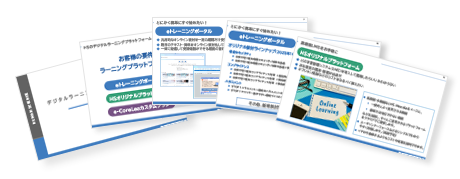2023.09.01
Are there any subsidies available for introducing e-learning?

After experiencing work style reforms and the COVID-19 pandemic, working from home and telework are becoming more established. As a result, there may be companies considering the transition to online internal training.
There are various formats for online training, such as live streaming by instructors at specific dates and times, or e-learning where learners can access and learn at their own convenience.
If it is the former, it can be implemented immediately as long as there is an environment where devices or applications for online meetings can be used. However, in the case of the latter, there are various decisions and preparations that need to be made before implementation, including the system, devices, and learning management.
Furthermore, the production and arrangement of learning materials are also necessary.
To start e-learning, it is necessary to consider and establish a system from the planning stage, as well as incur costs such as system implementation and material creation.
Costs may be a barrier and progress towards implementing e-learning may not go as smoothly as expected.
This time, I would like to focus on subsidies that can be one of the solutions in such cases.
1. Preparation and Cost for e-Learning Implementation
What preparations and costs are necessary when introducing e-learning?
●Creating an environment for receiving education (such as system implementation and internal organization)
●Establishing educational materials and training content
●Costs for participants (such as wages for the time spent attending the training)
※Please refer to the following for preparation and considerations for introducing e-learning.
>What is e-learning? Explanation of system overview and benefits
>What is the best e-learning platform for your company? Explanation of functions, types, and benefits of utilization!
To introduce a system, it is necessary to assign a person with specialized knowledge or to request a vendor. In addition, if you are building a server within your company, you will also need to arrange equipment and applications.
You will also need to arrange teaching materials and instructors (including teaching material supervisors).
In addition, wages will be incurred during employee training.
For companies that are about to introduce e-learning, it can be a significant burden. Therefore, why not consider utilizing subsidies?
2. Subsidy System for Education and Training
Here, we will introduce three types of subsidies from countries and local governments.
1. Human Resource Development Subsidy (Ministry of Health, Labour and Welfare)
2. IT Introduction Subsidy (Small and Medium Enterprise Agency)
3. Online Skill Up Subsidy (Tokyo Metropolitan Government)
1. Human Resource Development Support Subsidy
Related Sites: Subsidy System for Human Resource Development (Ministry of Health, Labour and Welfare)The Human Resource Development Support Subsidy is a system that subsidizes training expenses and a portion of wages during the training period when employers provide specialized knowledge and skills related to job duties to their employees through planned vocational training, etc. (quoted from the Human Resource Development Support Subsidy System website)
Seven courses are available, each with different content, methods, objectives, and target audience.
① Human Resource Development Support Course
② Education and Training Leave Grant Course
③ Investment Promotion Course for People
④ Business Expansion and Reskilling Support Course
⑤ Construction Worker Certification Training Course
⑥ Construction Worker Skills Training Course
⑦ Disability Vocational Skills Development Course
Among these, e-learning training is included in the subsidy target for the ① Human Resource Development Support Course, ③ Investment Promotion Course for People, and ④ Business Expansion and Reskilling Support Course.
Overview of "① Human Resource Development Support Course"
According to the 2021 Brochure (Detailed Version) for the "Human Resource Development Support Course", there are three requirements for the course.
If any of the training is conducted in accordance with the plan to acquire knowledge and skills related to job duties, a portion of the training expenses and wages during the training period will be subsidized.
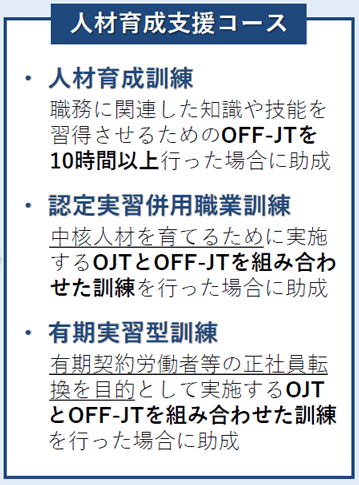
※Extracted from the 2023 Pamphlet (Human Resource Development Support Course) Detailed Version
For e-learning and education training through correspondence, if the standard learning time and learning period of the teaching materials meet the requirements, they will be eligible for subsidies.

※Extracted from the 2023 Pamphlet (Human Resource Development Support Course) Detailed Version
The target expenses are as follows.
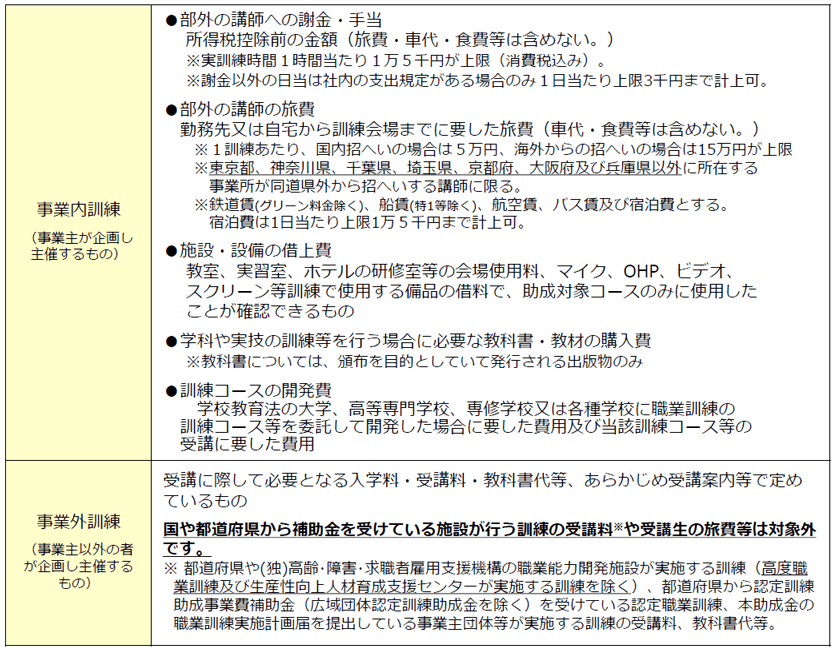
※Extracted from the 2023 Pamphlet (Human Resource Development Support Course) Detailed Version
Note: For e-learning, the following implementation methods are not applicable. For flat-rate services, they may be eligible for subsidies in other courses.
●e-learning training and simultaneous interactive communication training provided through flat-rate services ●Not intended for the acquisition of general knowledge and skills necessary for the public, but for the purpose of providing to specific employers (limited to training through e-learning and correspondence courses.)
In addition, expenses for reusable materials such as computer software and learning videos, as well as general-purpose computers and peripherals that can be used outside of vocational training, are not covered.
The amount and rate of subsidies are determined as follows.
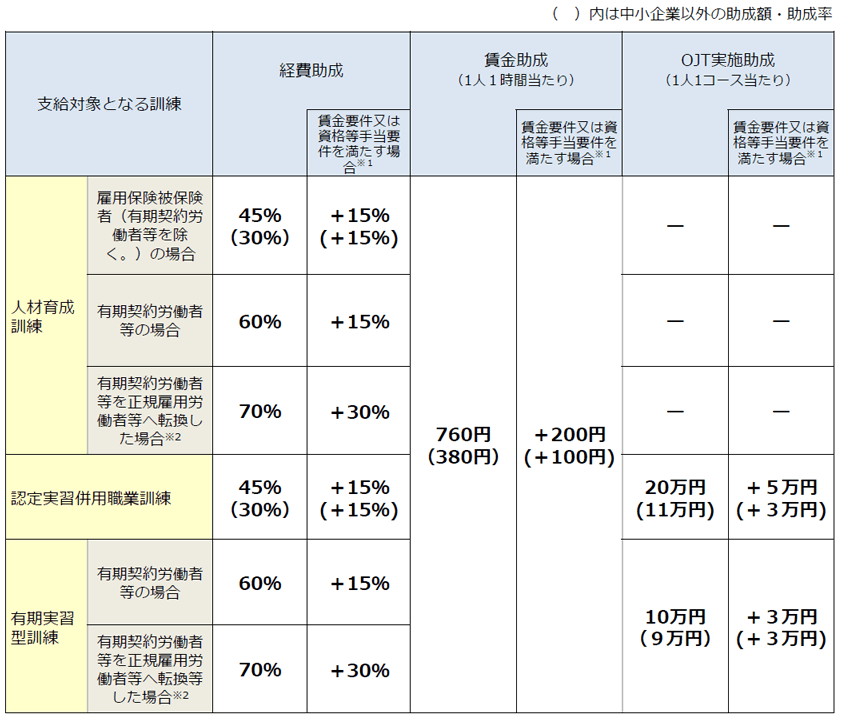
※Extracted from the 2023 Pamphlet (Human Resource Development Support Course) Detailed Version
The upper limit of the subsidy amount is here.

※Extracted from the 2023 Pamphlet (Human Resource Development Support Course) Detailed Version
The maximum amount of wage subsidies is 1,200 hours per person per training, and 1,600 hours for specialized practical education training.
There is also a limit on the number of times you can attend, with a maximum of 3 times per worker per fiscal year.
The total amount of subsidies that one company can receive in one fiscal year is 10 million yen.
In addition, requirements are also set for business owners and workers who can receive subsidies, so please check the details on the Ministry of Health, Labour and Welfare's website or pamphlet.
Overview of "Investment Promotion Course for ③ People"
According to the 2021 Brochure (Detailed Version of Investment Promotion Course for People), this course offers five training programs as a limited-time subsidy from the Reiwa 4th to 8th fiscal years to accelerate "investment in people".

※Extracted from the 2023 Pamphlet (Investment Promotion Course for Individuals)
e-Learning is eligible for subsidies in any training.
The subsidy rates are as follows.
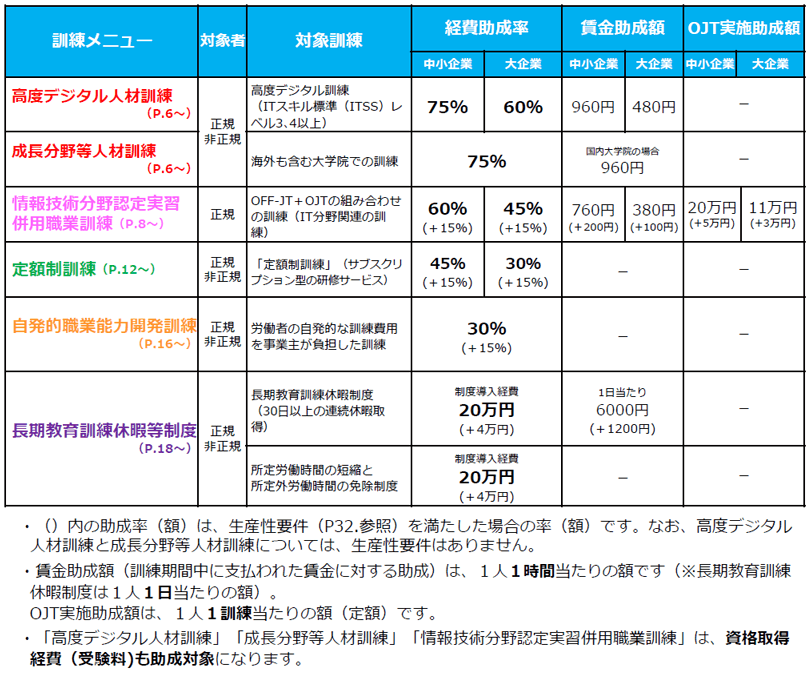
※Extracted from the 2023 Pamphlet (Investment Promotion Course for Individuals)
The maximum amount of subsidies is 25 million yen per fiscal year per company (excluding growth area human resource training, and voluntary occupational skill development training is 3 million yen). The maximum amount for growth area human resource training is 10 million yen.
In addition, the amount per person, number of days, hours, and number of courses are also specified.
Among the five trainings, the "Fixed-rate Training" is eligible for the subsidy as its name suggests, as it is a subscription service for unlimited training.
At the time of applying for the subsidy, the person who applied as a training participant must attend the eligible training for at least one hour, and the total of all participants must be at least 10 hours.
By the way, for fixed-rate training, expenses such as tablet or router rental fees, and LMS data entry services are not eligible for the subsidy, even if they are necessary for attending the training.
In addition to flat-rate training, there are conditions for receiving subsidies through e-learning for other types of training. Please check the Ministry of Health, Labour and Welfare's website or pamphlets for details.
Overview of "④ Business Expansion and Reskilling Support Course"
According to the 2021 version pamphlet (Business Expansion and Reskilling Support Course), this course is a limited-time subsidy for the period from 2021 to 2025.
This course is a system that subsidizes training expenses and a portion of wages during the training period when employers provide training to employees in new fields necessary for launching new businesses or expanding existing ones.
It also applies to acquiring specialized knowledge and skills necessary for promoting DX and carbon neutrality within the company, not just for business expansion.
In this course, the flat-rate e-learning service is also eligible for subsidies. Similar to the "Investment Promotion Course", it is a requirement to complete a certain amount of learning within a designated time for the designated person at the time of application.
The amount of subsidy is as follows.

※Extracted from the 2023 Edition Pamphlet (Business Development and Reskilling Support Course)
However, for e-learning, only subsidies for expenses are provided.
In addition, there are limits on the amount, training time, and number of courses that can be taken.
●Application Process
For all subsidies, it is necessary to create a training plan and apply in advance.
After applying, training will be conducted according to the plan, and within 2 months from the end of the training, the designated application documents will be submitted.
After review, the subsidy will be determined and paid out.
2. IT Introduction Subsidy
IT Subsidy for Small and Medium Enterprises is adopted by the Independent Administrative Institution Small and Medium Enterprise Agency and is operated by the Japan Association of Service Design Promotion Council under the supervision of the Agency and the Organization.
The target businesses are small and medium-sized enterprises, as well as small businesses.
This subsidy supports the introduction of IT tools (software, apps, services, etc.) for improving labor productivity and promoting business efficiency and DX.
There are "frames" and "types" for the amount of subsidy, subsidy rate, and eligible expenses for this subsidy. Among them, e-learning implementation (educational training process) is also eligible under the "regular frame".
The target of the subsidy includes expenses related to "IT tools", including software, options, and services. Specifically, it includes software purchase costs, cloud usage fees (up to 2 years), and implementation-related costs. Therefore, costs such as implementation consulting, creation of system manuals, and post-implementation maintenance support are also eligible for subsidies.
The subsidy is within half of the expenses, ranging from 50,000 yen to 4.5 million yen.

※Extracted from the 2023 IT Introduction Subsidy Application Guidelines Regular Category (Type A and B)
In addition, "Type A" and "Type B" are classifications based on the number of "processes" that are eligible for subsidies.
This subsidy is for IT implementation, so it covers not only e-learning, but also tools such as accounting systems, groupware, and inventory management.
If you implement IT across four or more processes as defined in the regulations, it will be classified as Type B.
"Processes" are defined as follows.
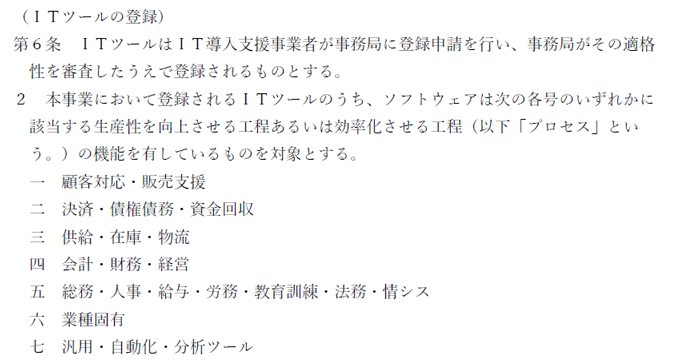
※Extracted from the Regular Frame of the Subsidy for IT Introduction Support for Productivity Improvement in the Fiscal Year of Reiwa 1
If you are applying for this subsidy, you will need to submit a business plan that includes the growth rate of labor productivity after IT implementation.
At the time of application, the examination will be conducted to determine whether or not the subsidy will be granted, but the specific amount will be determined after the completion of the business.
In particular, for Type B, there are more requirements, such as setting and achieving goals for the increase in total salary payments, compared to Type A, so please carefully consider before applying.
3. Online Skill Up Subsidy
The Online Skill Up Subsidy is a subsidy provided by the Tokyo Metropolitan Government and operated by the Tokyo Employment and Training Foundation.The expenses for vocational training using e-learning that is provided to employees will be subsidized.
The target is small and medium-sized enterprises and organizations with headquarters or offices in Tokyo. It is also a requirement that the training for which the subsidy is being applied for has not already received subsidies from the national or local government.
In addition, for businesses promoting DX, there is a separate DX Reskilling Subsidy available for vocational training, with different subsidy amounts. Therefore, it may be beneficial to consider this as well when promoting applicable businesses.
Now, for the online skill-up subsidy, even if the price is determined per single course for e-learning materials, flat-rate enrollment is also eligible. In addition, expenses such as ID registration fees and management of enrollment status are also eligible for operation.
However, please note that materials developed on a custom basis, as well as materials that are unrelated to occupation or job duties, or materials consisting solely of language acquisition or exam questions, are not eligible.
The amount of subsidy is as follows.

※Extracted from the FY2023 Online Skill Up Subsidy Site
If you receive this subsidy, you will need to submit an application form, undergo an examination, and then the amount of the subsidy will be determined after the training is completed.
3. Summary
We have introduced the subsidies available when introducing e-learning.
If the purpose of each subsidy matches the company's training policy, it is possible to improve the skills of employees with public support.
Some subsidies also have consultation desks, so we recommend that you take advantage of them.
Moodle implementation support to Human Science Co., Ltd.
At Human Science Co., Ltd., we offer implementation support services for the learning support system (LMS) "Moodle". "Moodle" is an open source type, which allows for initial cost reduction. We handle everything from the construction and design of "Moodle" to customization, plugin development, and operational support.
Moodle Features
●Management of learning progress and grades
●Rubric evaluation
●Multilingual support
●Customization of appearance
●Restriction of user permissions
●Management of learner groups
●Regular security updates
We can build an e-learning system that meets the needs of companies that want to introduce the most suitable e-learning to their own company. We also provide global human resource development services such as e-learning material production and translation.
>Moodle Implementation Support and Operation
>e-Learning Material Production
>e-Learning Material Translation (Multilingual Support, Localization)
Mito Electronic Technical College | Providing Online Classes with Moodle
We provided support for the introduction of "Moodle" for online classes due to the COVID-19 pandemic.
The request for support was made in April 2020 when the state of emergency was declared. We received a request for "Moodle" as it is open source and has a low introduction cost, and also because it has a wealth of information such as manuals available online and has a track record of being used in universities.
As a specialized technical school in the field of information processing, it seems that there were no difficulties for the teachers to use it. Even after the end of the COVID-19 pandemic, a hybrid model of face-to-face and online classes has become established, and efforts are being made to improve the quality of teaching.
Introducing case studies from Mito Electronic Technical College. Please refer to the following for details on infrastructure development for online learning.
>Realize Online Classes with Moodle: Providing Classes Even During School Closures
Latest Blog
- 04/02/2024
- English Learning Using Moodle and ChatGPT












